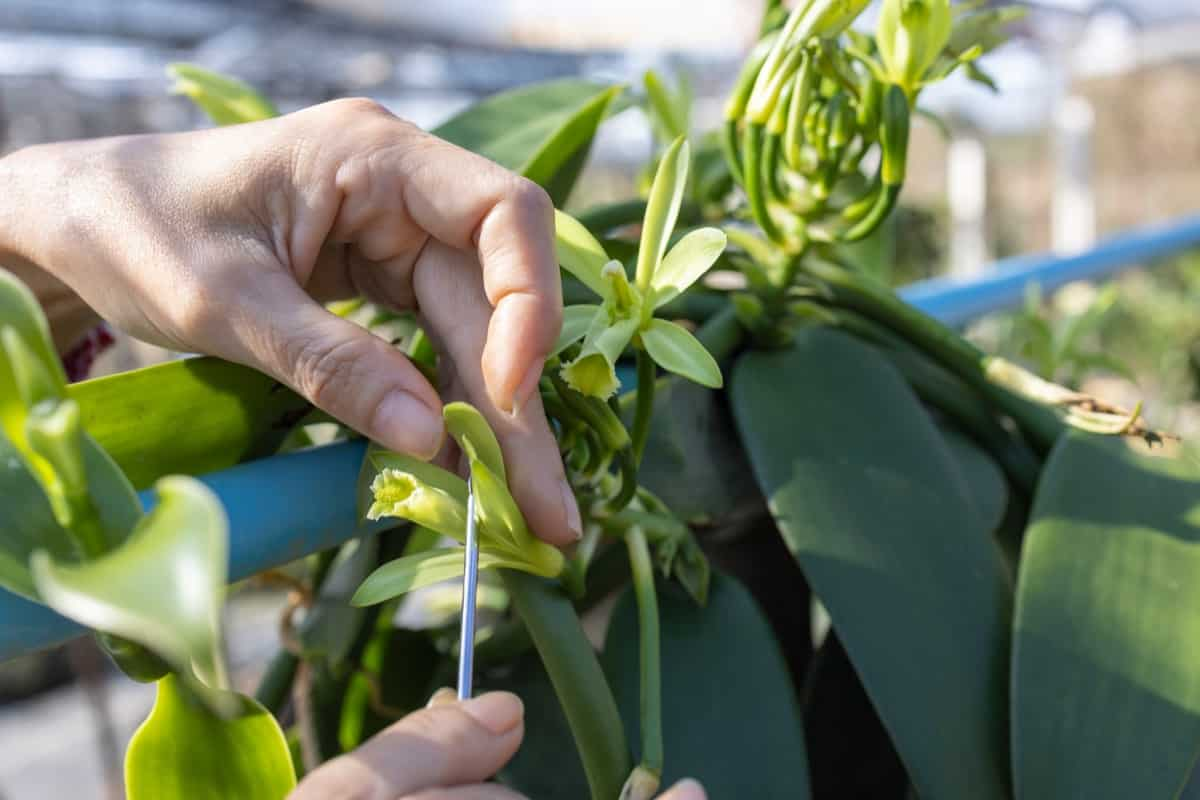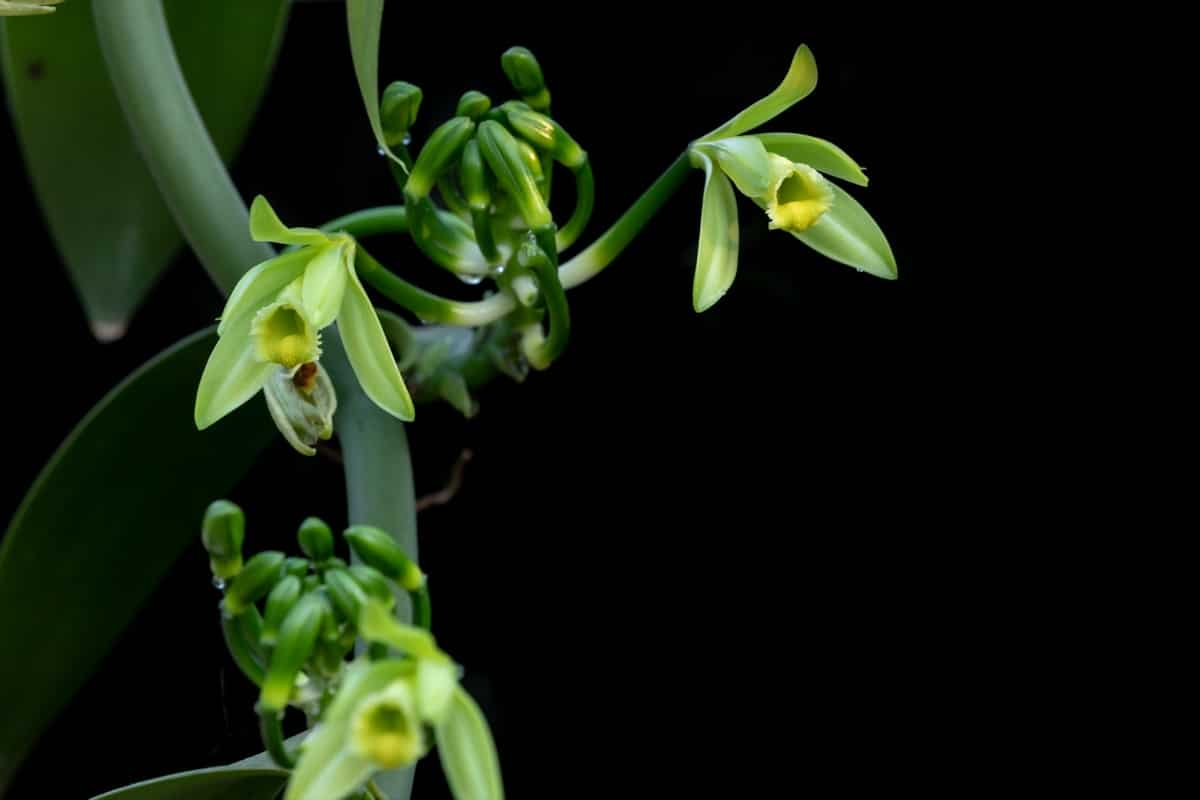The labor-intensive nature of cultivating vanilla is often understated. Among the numerous activities involved, one task stands out due to its delicacy and precision – the pollination of vanilla flowers. The Vanilla Pollination Bee, which naturally carries out this process, is absent in many vanilla growing regions, necessitating manual labor. This article is designed to guide readers on How to Hand Pollinate Vanilla, along with natural methods, tips, and the meticulous attention required.

How to Pollinate Vanilla Flowers
Best Time to Pollinate Vanilla Flowers
A perfect time for Vanilla pollination usually falls within the early morning hours. Timing is paramount, primarily because the Vanilla flower blooms once and lasts a mere day, specifically around 12 hours. The best time to pollinate Vanilla flowers is typically between early to mid-morning. After midday, the flowers wilt, diminishing the chances of successful pollination. Hence, farmers must be observant and act promptly to leverage the flower’s short life span. On the plus side, blooming periods are usually predictable, making it easier to plan the pollination process.
Natural Methods for Pollinating Vanilla Flowers
Vanilla flowers can be pollinated naturally, although the success rates can be quite variable. The natural pollination process involves the assistance of specific insects, notably the Vanilla Pollination Bee. This bee is specialized in navigating the complex structure of the vanilla flower, ensuring effective pollination.
Natural pollination is a reliable option in regions where these bees are abundant. Alternatively, other natural pollinators, such as hummingbirds, can also aid pollination. However, it’s worth noting that relying on natural methods might not guarantee a high yield, which is why hand pollination is common in commercial cultivation.
Hand Pollination Techniques for Vanilla Flowers
For those wondering, How You Pollinate Vanilla By Hand, the process is meticulous but achievable with practice. To pollinate the flower, the petals are gently opened to reveal the stamen and stigma located inside the flower. With a small, fine-tipped tool, like a toothpick, the cap separating the two is gently removed, allowing the pollen to contact the stigma. It is a delicate process requiring a deft touch and patience, but with practice, one can perfect the technique, thereby significantly increasing the chances of successful pollination.
In case you missed it: How to Pollinate Zucchini Flowers: Hand Pollination, Natural Pollination Methods, and Tips

Pollination Process of Vanilla Flowers
The overall Pollination Process of Vanilla Flowers, whether natural or hand-pollinated, is centered around the transfer of pollen from the stamen (male part) to the stigma (female part). The flower will die off once this process is successful, and the green bean will begin to develop. Over several months, this bean grows to full size, slowly acquiring the characteristic aroma of vanilla. It’s an extended process, and patience is a virtue that vanilla growers must cultivate along with their crop.
Signs of Successful Pollination in Vanilla Flowers
Successful pollination can be confirmed a few days after the pollination process. The Signs of Successful Pollination in Vanilla Flowers can be seen when the flower begins to wilt and a small pod forms at the base. This pod eventually grows into the vanilla bean, the ultimate reward for the pollination efforts. It is an exciting stage in the cultivation process, indicating that the laborious pollination task has been successful and the prospect of a bountiful harvest is in sight.
Common Challenges in Pollinating Vanilla Flowers
Despite the rewards, the path is fraught with Common Challenges in Pollinating Vanilla Flowers. The major challenge is the short blooming time of the flowers, necessitating timely pollination. Another challenge lies in the manual labor required for hand pollination, especially in large-scale cultivation. Furthermore, natural pollinators, like the Vanilla Pollination Bee, are unavailable in all regions, making natural pollination unreliable. There’s also the threat of diseases and pests that can compromise the flowers before they are pollinated.
Pollination Requirements for Growing Vanilla Plants
The Pollination Requirements for Growing Vanilla Plants involve a combination of appropriate climate, timing, and labor. A humid, tropical climate is most suitable for vanilla cultivation. The flowers bloom in such conditions, offering a narrow window for pollination. When the Vanilla Pollination Bee is absent, growers must perform hand pollination. This manual process, though labor-intensive, can be instrumental in ensuring a successful harvest, making it an essential requirement in vanilla cultivation.
In case you missed it: Natural and Organic Ways to Treat Squash Leaf Curl: Fix With Effective Home Remedies

Cross-pollination in Vanilla Plants
While most plants benefit from cross-pollination, this isn’t typical in Vanilla Plants. These plants tend to be self-fertile, meaning they can produce seeds using pollen. However, the complex structure of the flower makes self-pollination a rarity in the natural environment. Therefore, whether it’s a natural pollinator or a human, intervention is needed to facilitate the pollination process and ensure the development of vanilla beans.
Pollinators of Vanilla Flowers in the Wild
In the wild, the Pollinators of Vanilla Flowers primarily include the Vanilla Pollination Bee and certain hummingbird species. These creatures play a vital role in the life cycle of the vanilla plant. Especially the Vanilla Pollination Bee, native to Central and South America, is known to have co-evolved with the vanilla orchid, mastering the intricate task of pollinating these unique flowers. However, in regions outside the bee’s habitat, other means of pollination become necessary, often involving manual intervention.
Tips for Increasing Vanilla Flower Pollination Success
Here are some Tips for Increasing Vanilla Flower Pollination Success for growers seeking to optimize their yield. First, understand the timing of your vanilla flowers’ blooming period and be ready to pollinate them as soon as they open. Hand pollination, though labor-intensive, can drastically improve your chances of a successful harvest. Ensure the environment is conducive to growth – a humid, tropical climate is ideal. Finally, watch for pests and diseases that can compromise your flowers, taking preventative action whenever necessary.
Maintenance After Pollination of Vanilla Flowers
Post-pollination, it’s vital to provide the vanilla plants with meticulous care to ensure the successful development of vanilla beans. Regular watering is necessary, as vanilla plants thrive in humid conditions. However, ensure the soil is well-draining to prevent water-logging, which can cause root rot. Pruning is also essential; remove dead or diseased plant parts to maintain plant health and encourage vigorous growth. These steps are crucial in guaranteeing that the pollination efforts bear fruit, leading to the successful harvest of aromatic vanilla beans.
In case you missed it: Natural and Organic Ways to Treat Peach Leaf Curl: Fix With Effective Home Remedies

Conclusion
Cultivating vanilla, particularly pollination, is a delicate and time-sensitive task. Given the short blooming time of the flowers and the unavailability of natural pollinators in many regions, hand pollination is a crucial step for most growers. While this manual method may be labor-intensive, its rewards can be bountiful, yielding highly prized and flavorful vanilla beans.
Remember, the process requires keen observation, timely intervention, and patience. By understanding the plant’s natural rhythms, respecting its needs, and with regular practice, anyone can become adept at pollinating vanilla flowers and look forward to a successful harvest.
- Feed Your Flock for Less: Top 10 Tips to Save on Chicken Feed
- Ultimate Guide to Ossabaw Island Hog: Breeding, Raising, Diet, and Care
- Hatching Answers: The Top 10 Reasons Your Chickens Aren’t Laying Eggs
- Eggs and Economics: Breaking Down the Cost of Raising Backyard Chickens
- Defend Your Greens: Proven Methods to Keep Iguanas Out of Your Garden
- Ultimate Guide to Cinnamon Queen Chicken: A Comprehensive Guide for Beginners
- Ultimate Guide to California Tan Chicken: Breeding, Raising, Diet, Egg-Production and Care
- Ultimate Guide to Marsh Daisy Chicken: Breeding, Raising, Diet, and Care
- 10 Types of Chicken Farming Businesses You Can Start for Profits